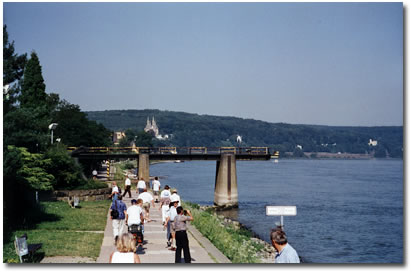|
|
|
|
|
|
 |
 |
|
|
| 9th
Infantry Division — World
War II — Remagen, Germany |
|
|
|
 |
 |
 |
 |
 |
 |
 |
|
The
Ludendorff Bridge at Remagen,
Germany, collapsed into the
Rhine River on March 17, 1945.
This is a photo of some of
the remains of the railway
bridge extending into the
river.
|
STORY FROM
EIGHT STARS TO VICTORY CONTINUED:
"With the capture of Bruchausen
accomplished, the 47th's 2nd Battalion's
troubles of the bridgehead started.
The enemy launched a counterattack
consisting of approximately fifty
infantrymen, three tanks and several
half-tracks. Artillery supporting
the 47th aided the footsloggers of
the 2nd Battalion to repel this assault,
but not without several losses for
the Americans.
"At 9:30 A.M. the 1st Battalion
of Lt. Colonel James D. Allgood made
its way across the bridge and reached
Orsberg. From there the 1st pushed
on to capture Scheuren, which is along
the north shore and a few hundred
yards up the road from the town of
Unkel. At Scheuren, too, the enemy
hurled one of his severe counterattacks,
but again he received a shellshacking.
"By 7:30 p.m. the 3rd Battalion,
commanded by Lt. Colonel William W.
Tanner, was in the bridgehead and
it struck east across the hills and
the Kas streamline to reach Ohlenberg,
which is approximately 2,000 yards
due east of Erpel. After a twelve-hour
house-to-house fight against a determined
group of defenders, who were aided
by self-propelled guns, tanks and
automatic weapons, the 3rd grabbed
Ohlenberg and got a moment's respite.
"Panzers and other available
elite tropps were reinforcing the
enemy on the bridgehead defenses now,
and the Luftwaffe opened its fight
to destroy the span. Artillery concentrations
increased from the hills beyond the
American lines and they were to become
even stronger with each passing day.
As the remainder of the 47th Infantry
streamed over the Ludendorff Bridge,
it became evident that the Nazis were
concentrating their growing power
on the mountainous terrain in the
center of the sector. With a fantaticism
born of sheer desperation at having
failed to destroy the span, the enemy
counterattacked fiercely and refused
to give up ground until he could hold
it no longer. Time after time the
Wehrmact attempted to split the expanding
bridgehead in two, drive to the bridge
and destroy it. German success would
have trapped the entire American force
building up the breakthrough on the
east bank, and the bulk of that force
on March 8th was the 47th Infantry.
"With only a prior quiver as
warning, the much-used Ludendorff
Bridge collapsed into the Rhine on
the afternoon of Saturday, March 17,
1945, St. Patrick's Day. Approximately
400 men were near or on the span when
it crumpled into a mass of twisted
steel and bodies. Although there were
pontoon bridges built and in full
operation at the time, this structure
was missed greatly and evinced one
choice remark from an Irish-American,
'This is a heck of a St. Patrick's
Day.'
"Despite the fall of the bridge
and the increased enemy armored and
artillery resistance as he was compressed
against the Wied River, the Ninth's
line was moved forward steadily. In
rapid succession, Kalenbornm Willschied,
Hallerbach and Vettelschoss were overrun.
More high ground was taken near Stroedter
Huegel and by the evening of the 18th,
the Allied bridgehead had control
of all the high ground overlooking
its original build-up perimeter."
[ Back
to Photographs • Previous
Photograph • Next
Photograph ]
|
 |
 |
 |
|
|
 |
|
 |
|
|
|
|
|
|
|
|
|
 |
 |
|